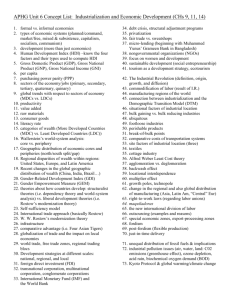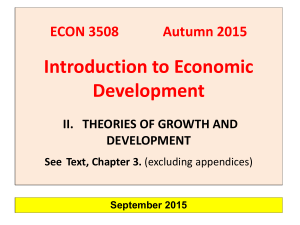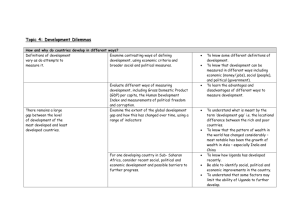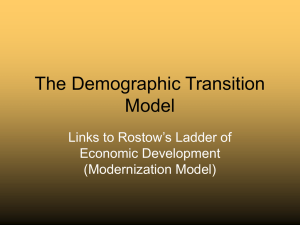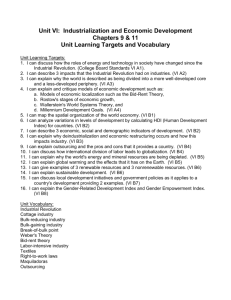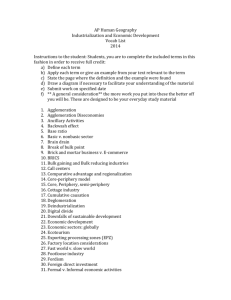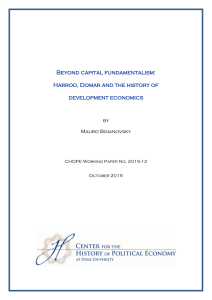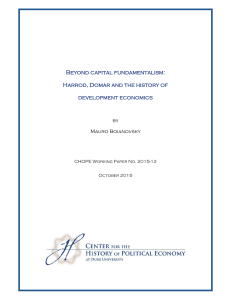Development-Market Approaches
advertisement
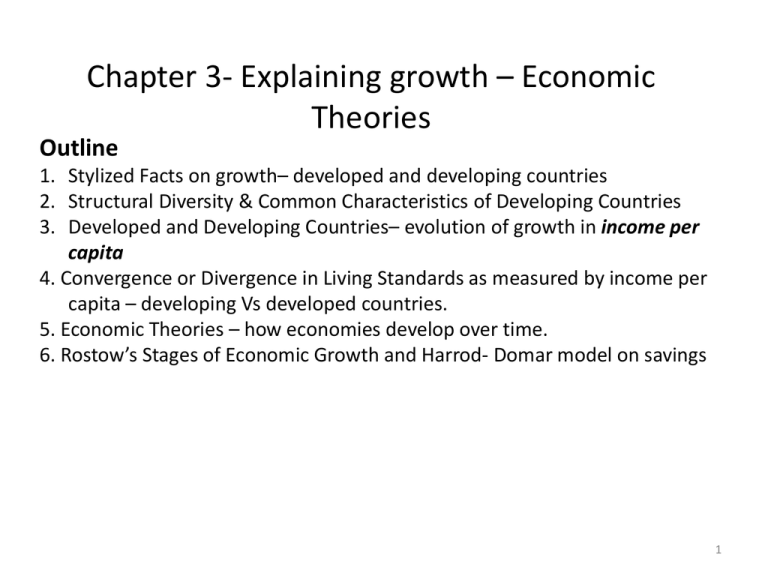
Chapter 3- Explaining growth – Economic Theories Outline 1. Stylized Facts on growth– developed and developing countries 2. Structural Diversity & Common Characteristics of Developing Countries 3. Developed and Developing Countries– evolution of growth in income per capita 4. Convergence or Divergence in Living Standards as measured by income per capita – developing Vs developed countries. 5. Economic Theories – how economies develop over time. 6. Rostow’s Stages of Economic Growth and Harrod- Domar model on savings 1 Economic Growth – the importance of growth in development Stylized Facts 1. For present developed countries, the GDP per worker has accelerated since 1820s. The average growth rate of 2% is impressive if one factors in compounding. 2. Growth (see Table 3.1) was not uniform across all countries; current developing countries only began the process after WW II. 3. Table 3.2 shows the growth rates of selected developing countries relative to the US. For many if not all, there is clear need for accelerated growth if these countries have to “catchup” with developed countries. i.e. they must grow at high rates to catch with developed economies. 4. Many theories related to economic growth emphasize particular pathways that these societies might pursue: (a) Linear view of history as societies move from agriculture to industrialization – Rostow: (b) Delayed consumption or savings where savings produce growth effects– Harrod-Domar; (c ) savings is important for only level effects (SR & MR but not in the LR) where technology matters –Solow Model; (d) new growth theories – Chapter 4 and so forth. 2 Economic Theories 1. Economic development theories and models seek to explain and predict how: (a) Economies develop (or not) over time (b) Barriers to growth can be identified and overcome (c ) Government can induce (start), sustain and accelerate growth with appropriate development polices 2. Theories are generalizations. While LDC's share similarities, every country’s unique economic, social, cultural, and historical experience means the implications of a given theory vary widely from country to country. 3. There is no one agreed ‘model of development’. Each theory, like Rostow, gives an insight into one or two dimensions of the complex process of development. e.g. Rostow helps us to think about the stages of development LDC's might take and the Harrod-Domar model explains the importance of adequate savings in that process. 3 ROSTOW, Walt W.(UT Austin: 1969-2003) This is a linear theory of development. Economies can be divided into primary secondary and tertiary sectors. The history of developed countries suggests a common pattern of structural change: The Stages of Economic Growth: An Anti-Communist Manifesto (1960) Stage 1: Traditional Society Characterized by subsistence economic activity i.e. output is consumed by producers rather than traded, but is consumed by those who produce it; trade by barter where goods are exchanged they are 'swapped'; Agriculture is the most important industry and production is labor intensive, using only limited quantities of capital. Stage 2 :Transitional Stage The precondition for takeoff. Surpluses for trading emerge supported by an emerging transport infrastructure. Savings and investment grow. Entrepreneurs emerge ( how they emerge is not spelt out) Stage 3 :Take Off Industrialization increases, with workers switching from the land to manufacturing. Growth is concentrated in a few regions of the country and in one or two industries. New political and social institutions are evolving to support industrialization. Stage 4 :Drive to Maturity: Growth is now diverse supported by technological innovation. 4 Implications of Rostow's theory Development requires substantial investment in capital equipment (K) ; to foster growth in developing nations, the right conditions for such investment would have to be created i.e. the economy needs to have reached Stage 2. For Rostow: 1. Savings and capital formation (accumulation) are central to the process of growth, hence development 2. The key to development is to mobilize savings to generate the investment to set in train self generating economic growth. 3. Development can stall at Stage 3 for lack of savings. Suppose the deficiency in savings is on the order of 15-20% of GDP. If S = 5% then foreign aid/loans of about 10-15% plugs this ‘savings gap’. Resultant investment means a move to Stage 4-Drive to Maturity and self generating economic growth, i.e. virtuous cycles (e.g. Botswana)and not vicious cycles (e.g. Argentina). 4. Once Stage 5(High Mass Consumption ) is achieved, this society continues to have high consumption and maintains such by incentives to savings plus additional key ingredients (good governance, property rights, human 5 capital and functioning institutions) Limitations of Rostow's Model 1.Rostow's model is limited. The determinants of a country's stage of economic development are usually seen in broader terms i.e. dependent on: (a) the quality and quantity of resources (b) a country's technologies (c) a countries institutional structures e.g. law of contract 2. Rostow explains the development experience of Western countries, well. However, Rostow does not explain the experience of countries with different cultures and traditions e.g. Sub Sahara countries which have experienced little economic development. Comment: Rostow’s Stages of Economic Development was essentially a statement repudiating The Communist Manifesto! 6 Harrod-Domar Model: Introduction to the Harrod-Domar model 1.The Harrod-Domar model developed in the l930s suggests savings provide the funds which are borrowed for investment purposes by firms (entrepreneurs). The economy's rate of growth (g)depends on: a. the level of saving (S) and the savings ratio (s =S/Y) b. the productivity of investment i.e. economy's capital-output ratio (K/Y =θ). With depreciation (δ=0), g= s/θ Example: if £8 (=K) worth of capital equipment produces each £1 of annual output (=Y), a capital-output ratio (θ=8/1=8)of 8 to 1 exists. A 3 to 1 ratio indicates that only £3 of capital is required to produce each £1 of output annually. 7 The figure above plots the relationship between historical rates of saving and recent income levels. It is clear for both developing and developed countries that the relationship is not a fixed proportion as suggested by the H-D model. Rather, the relationship appears to be nonlinear! Y (1/ )K AK The Table provides further evidence of the variability of the relationship between investment (I K ) and growth (Y ). Notice that the ratio of investment to the change in real GDP varies greatly not only among countries but across countries as well. Thus, the focus of the H-D model on rates of saving and investment does not inform us very much about a country’s rate of economic growth. Harrod-Domar Model Growth-theoretical Problems not addressed by Smith and his followers. a. Dynamic interactions among macro variables and the associated distinction between flows (saving and investment, say as dollars per year) and stocks (capital, measured in dollars or pounds at a point in time). The distinction between flows and stocks is inherently a dynamic problem easily dealt with by mathematics. b. By definition, net investment = (the increase in the capital stock – depreciation) – due to physical or economic wear. A high level of investment entails an increasing level of the capital stock. Thus high saving and investment are good for growth even if they are stationary, that is, not increasing. c. Without net investment, economic growth would be zero. Rapid depreciation due to investments of low quality is an important source of slow or even negative economic growth 10 over long periods (SSA for example). Harrod-Domar Model (continued) c. Link between efficiency and growth is a little complex. High levels of efficiency (via foreign trade or high human capital investment) contributes to growth by amplifying the effects of a given level of saving and investment on the growth of output. A steady accumulation of capital through saving and investment, given a level of efficiency and technology, translates capital accumulation into economic growth. d. Around the 1950s, Roy Harrod and Evsey Domar expressed these relationships in a simple equation which formalized over 200 years of theorizing about economic growth. According to Harrod-Domar, economic growth depends on just 3 factors: (a) saving rate [+] --- determined by households; (b) the capital/output ratio [-]--- reflects the way firms base their demand for capital on the amount of output they want to produce; and (c ) the depreciation rate [-]--- a consequence of the quality of investment decisions in the past. 11 Three Problems in the Harrod -Domar Model a. b. c. d. Assumption about the way households choose to between consumption (C ) and saving (S). Assumed households save a fixed proportion of income. Has a reasonable basis in theory. The way firms choose to adjust their capital stock to output. The assumption that firms want to keep their capital stock in a fixed proportion to their output (K/Y), which makes the capital/output ratio an exogenous behavioral parameter in the model. This requires further examination of the link between capital and output. H-D did not allow any room for a crucial factor of production, labor. H-D explains output growth solely by saving and efficiency and yet there was evidence even in the 1950s that population or labor-force growth should be included. These omissions and implausible assumptions lead to the Second Revolution – the Neoclassical Model by Solow. 12 The Harrod-Domar Model (1)Y (t ) C (t ) S (t ) (2)Y (t ) C (t ) I (t ) (3) S (t ) I (t ) (4) K (t 1) (1 ) K (t ) I (t ); s S (t ) / Y (t ) (5) s / g ; g [Y (t 1) Y (t ) / Y (t )]; K (t ) / Y (t ) (6) s / (1 g*)(1 n) (1 );1 n P(t 1) / P(t ) (7) s / g * n g* s / n g* is the rate of per capita growth. Given θ,δ, s and n, were should be able to achieve a desired level of per capita growth (g*). Problem: this assumes that δ, θ, n, and s are exogenous. It urns out that (1). savings (s) is endogenous, and so is (2) population growth (n). Endogenous Savings: savings =f(income per capita) – societies with different income levels exhibit different savings (capital accumulation) and hence investment, thus economic growth. Endogenous population: population growth does change with the level of development, i.e. the demographic transition model – impacts savings and hence economic growth. 13 Further Analysis of the H-D Model The Harrod-Domar model developed in the 1930’s to analyze business cycles. it was later adapted to ‘explain’ economic growth. Economic growth depends on the amount of labor and capital i.e. Y = f(K,L) ceteris paribus on all other factors. (a) Developing countries have an abundant supply of labor (L). So it is a lack of physical capital (K) that holds back economic growth hence economic development. (b) More physical capital generates economic growth(use Production Possibility Frontier (PPF) for illustration.) (c ) Net investment (i.e. investment over and above that needed to replace worn out capital (deprecation) leads to more producer goods (capital appreciation) which generates higher output and income. Higher income allows higher levels of saving Question: Does an ↑S→↑Y OR Does an ↑Y→↑S? Older Theories suggested that ↑S→↑Y BUT newer theories point to the possibilities that ↑Y→↑S? . It is a causality issue and not correlation. 14 Implications of the Harrod-Domar Model Economic growth requires policies that encourage saving and/or generate technological advances ( no explanation as to how to promote this), which lower capital-output ratio. Criticisms of the model: Domar on Domar: My purpose was to comment on business cycles, not to derive "an empirically meaningful rate of growth." (a) It is difficult to stimulate the desired level of domestic savings (b) Meeting a savings gap by borrowing from overseas causes debt repayment problems later and other associate issues (HIPC– Bono’s crusade) (c) Diminishing marginal returns to capital equipment exist so each successive unit of investment is less productive and the capital to output ratio rises. Attempts to stimulate FDI is less successful for slow-growing economies unless they possess oil and other strategic natural resources, e.g. Nigeria (d ) The amount of investment is just one factor affecting development e.g. supply side approach (free up markets); human resource development (education and training) (e ) Economic growth is a necessary but not sufficient condition for development (f) Sector structure of the economy important (i.e. agriculture v industry v services) 15
